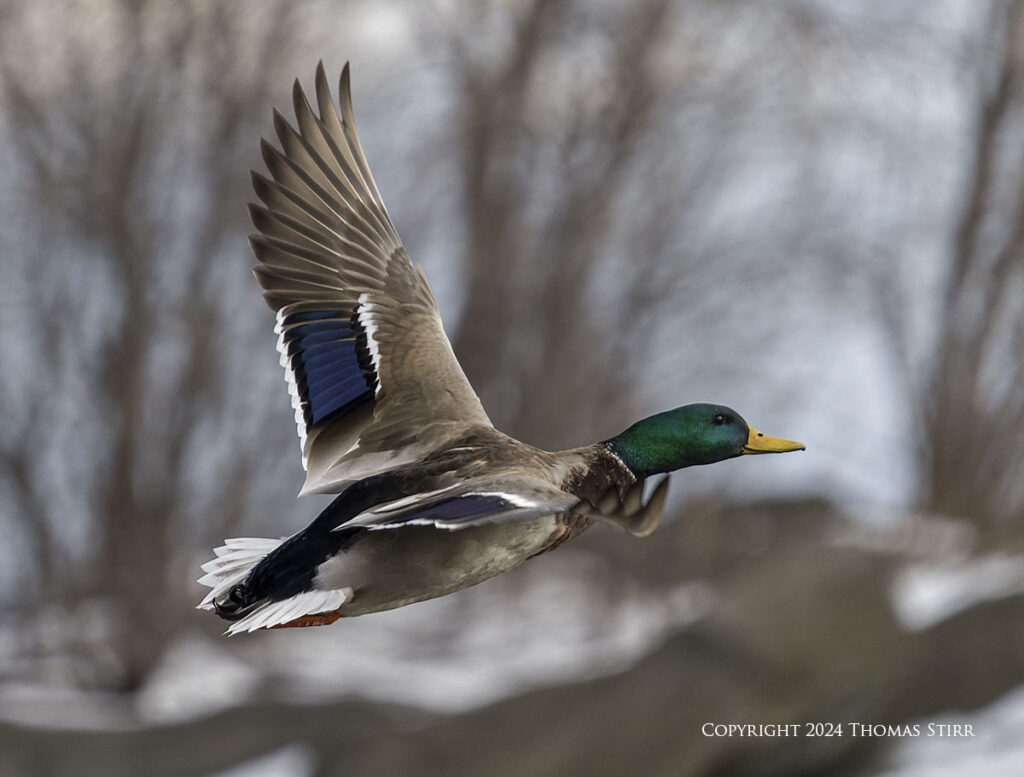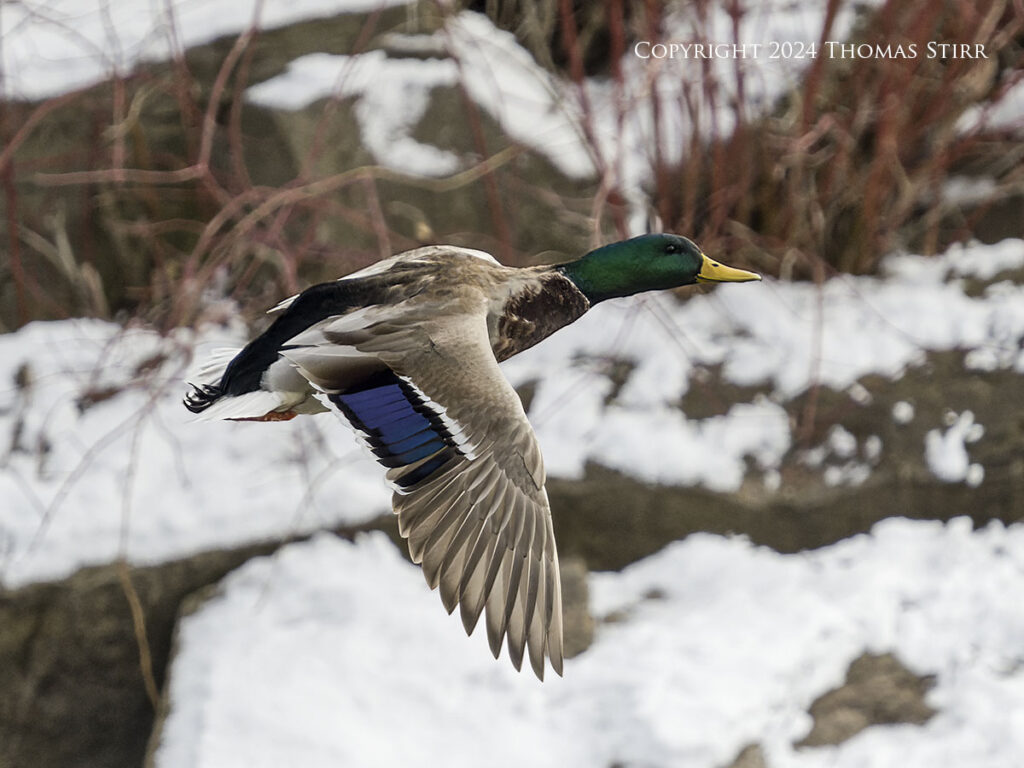During the past few days I’ve been practicing my BIF handheld technique with mallards at Forty Mile Creek in Grimsby. The spring birding season is fast approaching, so getting in some practice sessions in advance is absolutely critical.
NOTE: Click on images to enlarge.

Practicing birds-in-flight (BIF) with mallards is a practical thing for me to do since these birds are very common in our area.

Mallards are reasonably fast flyers and tend to take off fairly quickly. Their flight paths are more direct/arching in nature, rather than erratic. This makes them good practice subjects.

As regular readers know I use a combination of Bird Detection AI Subject Tracking with Pro Capture L for the majority of bird-in-flight photography.

After quite a bit of experimentation a couple of years ago, I’ve found this combination works best for me. Whether it will be appropriate for other photographers is something only they can assess.

When practicing BIF with mallards I have a number of different factors to monitor. As is the case with all bird photographers, eye/hand coordination is a critical skill for me to reinforce.

It is also important that I practice my ‘delayed’ shutter timing. Pro Capture L stores images in temporary memory while I half depress my shutter release. These photographs are only written to my memory card when I fully depress my shutter release.

Since I wait for the bird’s behaviour to actually happen before I fully depress my shutter release… my timing is slightly delayed when compared to most photographers. A few years ago when I first began to shoot using this technique it felt very odd… and counterintuitive. Now it feels perfectly normal and natural.

A fundamental skill that I practice is keeping a subject bird framed properly in my viewfinder, while panning with it in flight. Early in the spring birding season my eye/hand coordination tends to be a bit rusty and definitely is in need of reinforcement..

I also need to practice quickly responding to specific visual and auditory cues from my E-M1X camera. Bird Detection AI Subject Tracking will signal it has acquired auto-focus on a subject bird by creating a green box on its head/eye, or around it… depending on the subject distance. Pro Capture L will give me an auditory beep when it has acquired focus and is spooling images into temporary memory.

To be successful I need to do monitor all three of these things. Keep my subject bird in frame while I’m panning with it and watching for interesting mid-air motions. Stay aware of Bird AI’s green AF box. And, make sure I hear the Pro Capture L beep confirming auto-focus acquisition. When all three of those things happen concurrently, I know I’ll have a successful image run when I fully depress my shutter release.

For well over a decade I’ve used a single auto-focus point for all of my photography, regardless of the subject matter. This include the use of Olympus/OM System computational photography technology like Pro Capture L/H, Handheld Hi Res, Live ND, and In-Camera Focus Stacking.
Using a single, small auto-focus point with Bird Detection AI Subject Tracking on my E-M1X helps me capture images like the one above, and the one that follows.

I know that other photographers use multiple auto-focus points with Bird Detection AI Subject Tracking. A 5X5 grid is one of the most common configurations many folks use.

I’ve tried this in the past, but a 5X5 grid has never worked well for me when using Bird Detection AI Subject Tracking.

I’ve found the more auto-focus points I use with Bird Detection AI… the more likely it is to confuse my camera and cause the auto-focusing to drift off my subject bird-in-flight. I have no idea how Bird Detection AI works with the OM-1 or OM-1 Mark II as I’ve never used those bodies.

Practicing BIF with mallards usually starts with easy to capture images of birds doing fly-bys against the sky. These are good practice photographs to get my shutter release timing up to speed.

I then practice with mallards in-flight against various background elements like rocks, trees, and human-made structures.

Photographing BIF against various backgrounds is helpful to build some patience and improve my shot discipline, as it is important to wait for the Pro Capture L ‘beep’ to sound.

I have Pro Capture L set to 18 fps (frames per second) with 20 Pre-Shutter Frames. My Frame Limiter is turned off. I very seldom take any long, continuous C-AF runs.

I often take a series of very short ‘pulse’ capture runs using Pro Capture L. Many of these short image runs are not activated long enough to even yield 20 Pre-Shutter frames.

Typically these are when a bird is in free flight and not near any obstructions in the foreground.

I will often quickly reacquire auto-focus multiple times as a bird is approaching, and sometimes grab small groupings of images at critical moments of the approach. These include a bird spreading its flight feather to slow down in mid-air… or make a turn…. or dive.

I’ll half depress my shutter release for longer durations if a bird is coming in to land amongst other birds or approaching a jumble of objects on the ground or along the shoreline.

In these situations it is important to begin my Pre-Shutter frames while the subject bird is still well separated from the obstructions it is approaching.

That allows me to follow the bird right into a crowded landing area, or close to some obstructions in the background/foreground that are fairly close to the bird’s flight path. Practicing BIF with mallards is always beneficial to help hone my skills… and it’s also a lot of fun.

My recent photography outings have also given me the opportunity to wear my Cotton Carrier G3 Harness for 2 Cameras for longer durations. My thanks to Ray Miller for capturing a few images of me wearing the Cotton Carrier G3 Harness.
In the image above you can see my current birding set-up clipped onto and locked into the G3 Harness for 2 Cameras. The mounting bracket for the second camera is visible in this image.

For my style of handheld shooting with heavier camera gear the Cotton Carrier G3 Harness for 2 Cameras is ideal. After multiple outings with this harness I haven’t experienced any arm, neck or back fatigue. The design of the harness evenly distributes the weight of my gear across my back and shoulders which I find extremely comfortable even for extended periods of time.
In the image above the G3 Harness is still fully supporting the weight of my birding set-up. When my camera and lens are moved to a horizontal position the set-up is no longer locked into the G3 Harness. This allows me to quickly raise my camera to my eye as photographic opportunities present themselves.
I will be doing a full review of the Cotton Carrier G3 Harness for 2 Cameras in the next few weeks.
Technical Note
Photographs were captured handheld using camera gear noted in the EXIF data. Images were produced from RAW files using my standard process. I used my standard birds-in-flight camera settings for all of the images in this article. I engaged Bird Detection AI Subject Tracking in combination with Pro Capture L. I had my Pre-Shutter Frames set to 20, with my Frame Limiter turned off. I used a C-AF frame rate of 18 fps with a single, small AF point active. This is the 1,358 article published on this website since its original inception in 2015.
How you can help keep this site advertising free
My intent is to keep this photography blog advertising free. If you enjoyed this article and/or my website and would like to support my work, you can purchase an eBook, or make a donation through PayPal. Both are most appreciated.
Sometimes all we need as photographers is a bit of inspiration. We hope you can find some of that inside Finding Visual Expression II.
Finding Visual Expression II is available for download for an investment of $11.99 CDN. The best viewing experience of this eBook will be at 100% using Adobe Acrobat Reader.
You may be interested in all of the 30 concepts covered in both of these related eBooks. If so, you may want to also consider Finding Visual Expression.
Finding Visual Expression is available for download for an investment of $11.99 Cdn. The best viewing experience of this eBook will be at 100% using Adobe Acrobat Reader.
Our other eBooks include Images of Ireland, New Zealand Tip-to-Tip, Nikon 1: The Little Camera That Could, Desert & Mountain Memories, Images of Greece, Nova Scotia Photography Tour, and a business leadership parable… Balancing Eggs.
If you click on the Donate button below you will find that there are three donation options: $7.50, $10.00 and $20.00. All are in Canadian funds. Plus, you can choose a different amount if you want. You can also increase your donation amount to help offset our costs associated with accepting your donation through PayPal. An ongoing, monthly contribution to support our work can also be done through the PayPal Donate button below.
You can make your donation through your PayPal account, or by using a number of credit card options.
Word of mouth is the best form of endorsement. If you like our website please let your friends and associates know about our work. Linking to this site or to specific articles is allowed with proper acknowledgement. Reproducing articles, or any of the images contained in them, on another website or in any social media posting is a Copyright infringement.
Article is Copyright 2024 Thomas Stirr. Images are Copyright 2024 Thomas Stirr or Raymond Miller. All rights reserved. No use, duplication or adaptation of any kind is allowed without written consent. If you see this article reproduced anywhere else it is an unauthorized and illegal use. Posting comments on offending websites and calling out individuals who steal intellectual property is always appreciated!




Tom, wonderful collection of images. Your creative uses of Pro Capture are always interesting to read about and see the results in your photos. I always enjoy photographing Mallards, they can be very expressive, even comical birds. Looking forward to your review(s) of the new OMS 200-600 lens.
Hi Edward,
I’ve been using Pro Capture L and H for the vast majority of my bird-in-flight photography since I moved over to the Olympus/OM System family. I don’t recall OM Systems releasing a 200-600 lens… perhaps you’re thinking of Sony or Canon?
Tom